Balduinstein / Schaumburg
This castle was not on our itinerary in 2008, but we ran into it by accident on the way to another location. So.... we decided to stop and take a look. There is not too much left, but it does have some interesting elements to the interior.
Right, a view of Balduinstein from above.
Below, the way into the castle grounds. The castle is next to a private residence with a very large and loud German shepherd! Don't let it throw you and cause you to retreat!
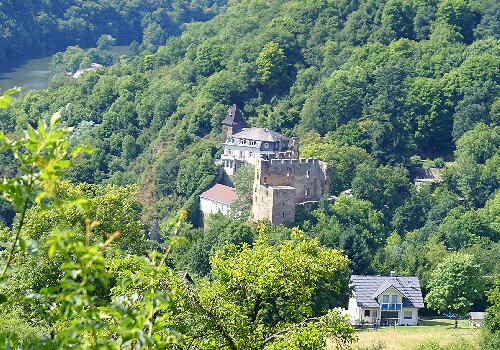
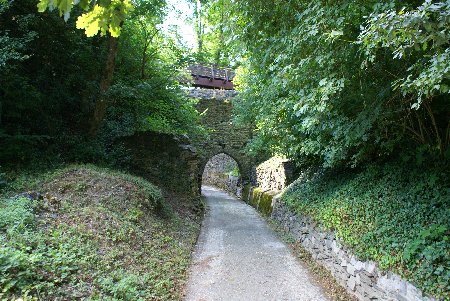
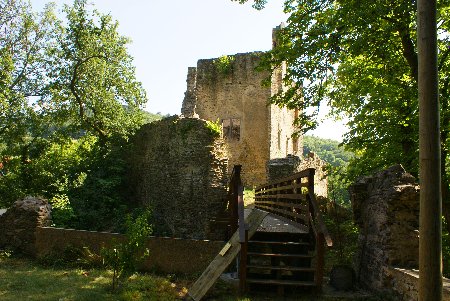

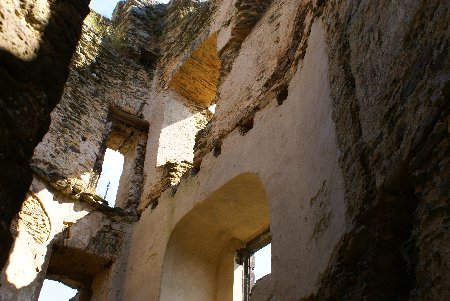


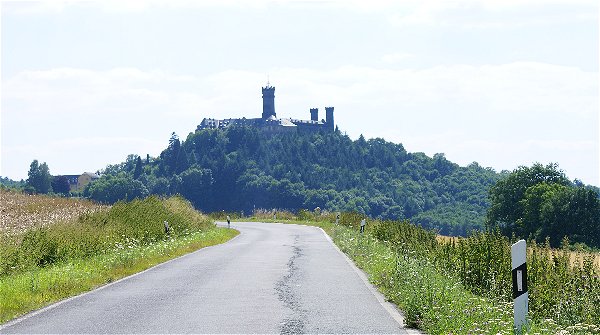
Balduinstein was started in the early 1300s, named after Baldwin of Luxembourg the Archbishop Trier (1285-1354). As it was built on a small bluff over the town, it was named Baldwin Stone, or Balduinstein. It was built as a way to control the local trade as part of the Luxembourg-Bavarian party attempting to control the Holy Roman Empire against the Austrians. The castle was built within one year, a remarkable achievement for that time. The castle never saw any serious fighting, but it did serve as the basis of significant disputes between major parties vying to control the empire, as it had to contend with the families that controlled the nearby Scahaumburg. Today, a youth organization is housed in part of the castle but the ruins are open for viewing.
Below, take the walkway across the dry moat and you enter the outer ward.
Below, a view of the main castle from the streets below. The castle would dominate the town and thus any who would dare to challenge the authority of the local lord.
Right, a view within the interior... or what is left of it. If you look closely you can see the mounting points for the floor joists. The interior had at least three floors and a roof area to provide defense. Evidence of repair work in the form of a paste along the wall is obvious.
Below, another portion of the interior. The window area to the left shows evidence of recent repair work, most likely efforts to shore up any damage.
Right, the view upwards towards a main fireplace that served the second floor. The mounts for the joists are obvious. The window at left has had some reconstruction, but the seats that are so prevalent among castles in Germany are apparent.
The official Balduinstein website (no longer functional).
Below right, a view of Schaumburg. When we went there the place was closed. It is far more well-preserved schloss than the ruin of an older fortress. The castle was once the home of the Graf von Westerburg in the 1300s. At one point, or so says the legend, the Graf was swindled of his lands during a drunken party with the lord of the Balduinstein!
Earliest records on the Schaumburg castle show it owned by the Leiningen family in 1197, though there is indication the site goes back to 915. Its key location saw it change hands frequently, going to the Nassau and Westerburg families among others. In 1656, the castle was sold to the widow of Peter Melander, a general who had served the Imperial Holy Roman Emperor during the Thirty Years War. Later family members continued to maintain the castle and even slightly expand it.
The Schaumburg castle has another interesting aspect to its history. Erbprinz Josias zu Waldeck-Pyrmont was born in the castle in 1896, his family having received the property in 1887 through a legal challenge. He served first as an enlisted man and then officer in World War I. After the war he joined the Freikorps in the chaos of early Weimar Germany and joined the Nazi party in 1929. He served as Heinrich Himmler's personal adjutant in 1930, and participated in the purge of the SA leadership in 1934. He also served in the Reichstag from 1933 to 1945. He later held both SS and Waffen-SS general rank, and was sentenced to life imprisonment after the war. Released due to poor health in 1950, Waldeck-Pyrmont returned to the Schaumburg castle and allowed the Red Cross to use it to trace missing persons due to the devastation of the war. He died there in 1967.
Schaumburg Castle's official site (no longer functional).